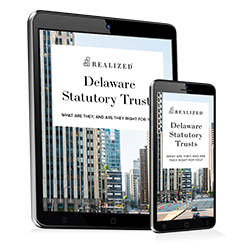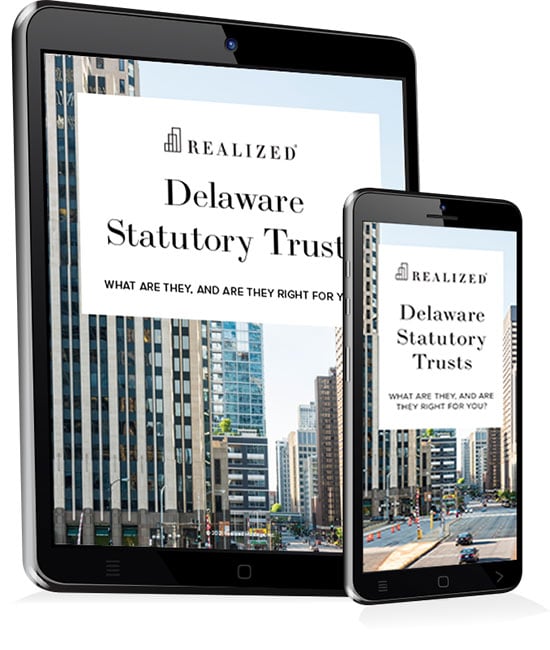Realized was recently featured on the Multi-family Investor Podcast while attending the ADISA Spring Conference. In this conversation, we discussed the potential benefits that 1031 Exchanges and Delaware Statutory Trusts (DSTs) may have for investors. Here are some of the key takeaways from this conversation.
There are many potential benefits to investing in Delaware Statutory Trusts and 1031 Exchanges to build your investment portfolio. A DST is a legal entity that can hold multiple commercial real estate properties. A 1031 Exchange is a real estate exchange where investors sell one property and then use the capital from that sale to immediately purchase another property, called a replacement property. 1031 Exchanges allow investors to defer capital gains taxes.
Investors can use 1031 Exchanges to invest in DSTs, which can be a source of passive income for investors who are retired or are approaching retirement. Because DSTs are made up of multiple commercial real estate properties, they are a way to diversify your portfolio. A potential advantage of investing in a DST is that the investor does not have to manage the properties as DSTs are usually managed by a commercial real estate Sponsor. This helps clients pursue the financial benefits of commercial real estate investment without the stress of direct management.
When investors use a 1031 Exchange to invest in a DST, this allows for continued appreciation with a diverse portfolio of properties across different markets. After selling a rental property, many investors find themselves with an income gap to make up. Filling this income gap is particularly crucial for those in retirement. The 1031 Exchange allows investors to fill that income gap quickly and even increase that passive income by seeking investments in growing sectors like multi-family properties.
How Does Realized Help Investors?
Realized offers wealth management solutions that help individual investors transition from owning one property to building a larger portfolio. We work closely with our clients to create a custom portfolio that addresses their financial needs and goals. During the initial portfolio building process, we ask clients about their future plans: What type of investments do they envision for the future of their portfolio? What are their passive income requirements? Are they using their investments as an estate planning tool? These insights help us determine what strategies are best for each individual client.
We also provide ongoing education about DSTs and help our clients find new opportunities for portfolio diversification. A diverse portfolio can help manage risk and keep passive income levels steady. Commercial investment firms have already been using 1031 Exchanges for decades, but Realized makes these strategies available to retail investors.
Realized clients also have access to the Realized Marketplace. This marketplace allows accredited investors to browse a wide range of 1031 Exchange-eligible properties to potentially include in their investment portfolio. The platform is open architecture and non-proprietary. Finding properties that are 1031 Exchange-eligible can be tricky, so the Realized Marketplace removes some of that legwork to streamline the process.
What Are the Pros and Cons of DSTs?
We have found that DSTs offer plenty of advantages for investors that are transitioning from single property ownership to a larger portfolio. The biggest advantage is that you will get capital gains tax deferral through the 1031 Exchange, which keeps more of your wealth working for you. DSTs also provide income directly after closing, so you won’t have to wait to see financial benefits.
Because DSTs are professionally managed, you’ll know exactly what you’re investing in, and you can select the DST that best meets your investment needs. The Realized Marketplace has a selection of multi-family properties to choose from, and investors can typically expect occupancy rates that are over 80 percent. For those that would like to eventually return to direct real estate investment, that optionality is there as well with a DST. Partial 1031 Exchanges are also an option in the future with DSTs.
Should Investors Also Consider QOZs?
When building a portfolio of multifamily properties, another vehicle that investors might be considering is a Qualified Opportunity Zone, or QOZ. DSTs and QOZs are both investment options, but they have different risk levels and income potential to consider. A QOZ is an investment property in a designated low-income community.
There are thousands of QOZs across the country, and they can deliver strong returns in the long run. However, they aren’t the best option for every investor. While QOZs offer some level of tax deferral, investors can expect a taxable event at some point after the initial investment. QOZs are also ground-up developments, which means that they can come with a high financial risk. Investors will not see income right away with a QOZ.
We have found that DSTs are generally a better option for investors who are seeking to manage risk and defer taxes while investing in multifamily properties. They also generate income right away, which is a big advantage for investors that are looking for passive retirement income.
What Can We Expect from DSTs Moving Forward?
The DST market is evolving, with lots of exciting innovations and diversification moving forward. Property values are high right now, which has resulted in a seller’s market. DSTs are becoming more popular among retail investors because they provide a unique opportunity to diversify. The switch from in-person to remote work has caused unique migration patterns that have stimulated certain real estate markets, and many DSTs focus on these opportunities for growth.
We’ve seen large institutional players get into the DST space in recent years. This has resulted in a wider range of DST Sponsors and opportunities for investors to choose from. More 1031-eligible properties may mean more opportunities to diversify. This has also created healthy competition that results in efficiency and transparency in the DST space.
This material is for general information and educational purposes only. Information is based on data gathered from what we believe are reliable sources. It is not guaranteed as to accuracy, does not purport to be complete and is not intended to be used as a primary basis for investment decisions. It should also not be construed as advice meeting the particular investment needs of any investor. Realized does not provide tax or legal advice. This material is not a substitute for seeking the advice of a qualified professional for your individual situation. Diversification does not guarantee a profit or protect against a loss in a declining market. It is a method used to help manage investment risk. No public market currently exists and one may never exist. DST programs are speculative and suitable only for Accredited Investors who do not anticipate a need for liquidity or can afford to lose their entire investment. There is no guarantee that the investment objectives of any particular program will be achieved. The actual amount and timing of distributions paid by programs is not guaranteed and may vary. There is no guarantee that investors will receive distributions or a return of their capital. These programs can give no assurance that it will be able to pay or maintain distributions, or that distributions will increase over time.Costs associated with a 1031 transaction may impact investor’s returns and may outweigh the tax benefits. An unfavorable tax ruling may cancel deferral of capital gains and result in immediate tax liabilities. Investors in QOFs will need to hold their investments for certain time periods in order to receive the full QOZ Program tax benefits. A failure to do so may result in the potential tax benefits to the investor being reduced or eliminated. If a fund fails to meet any of the qualification requirements to be considered a QOF, the anticipated QOZ Program tax benefits may be reduced or eliminated. Furthermore, a fund may fail to qualify as a QOF for non-tax reasons beyond its control, such as financing issues, zoning issues, disputes with co-investors, etc. Distributions to investors in a QOF may result in a taxable gain to such investors. The tax treatment of distributions to holders of interests in a QOF are uncertain, including whether distributions impact the aforementioned QOZ Program tax benefits. A QOF must make investments in Qualified Opportunity Zones, which carries the inherent risk associated with investing in economically depressed areas.



